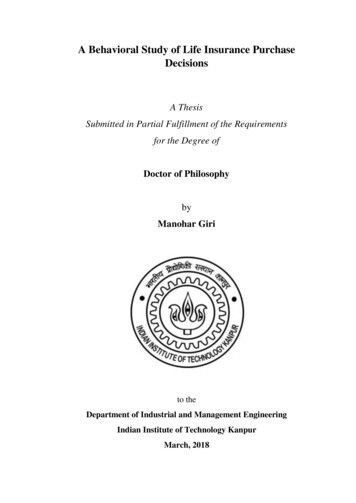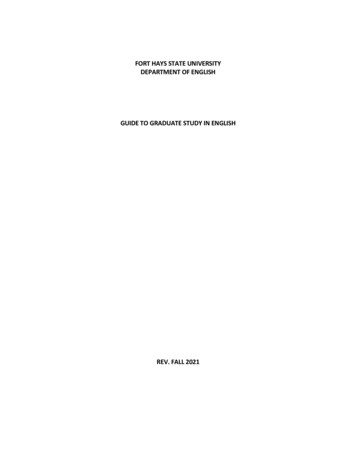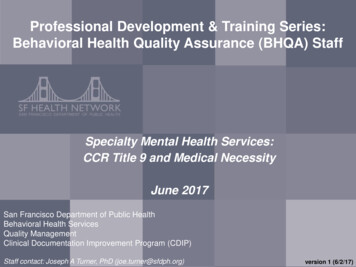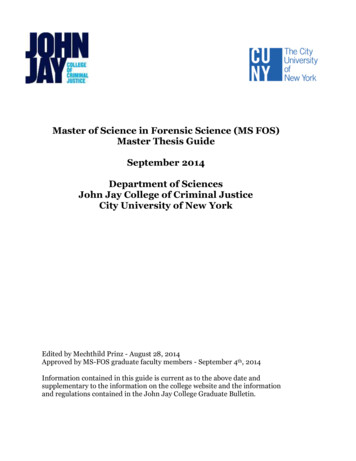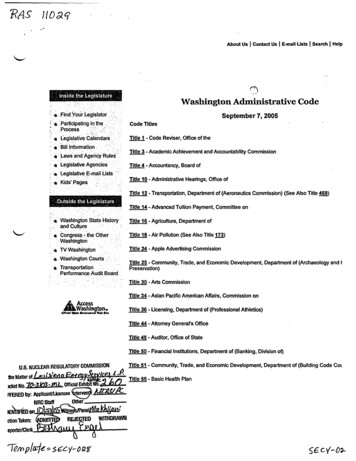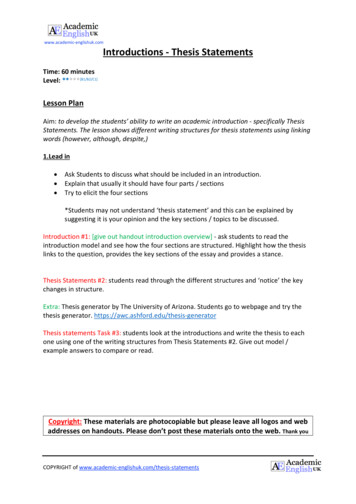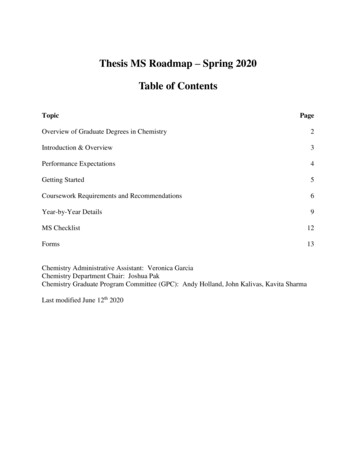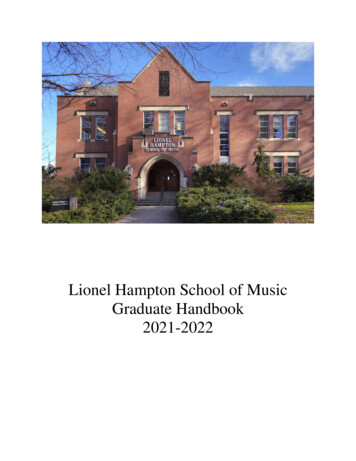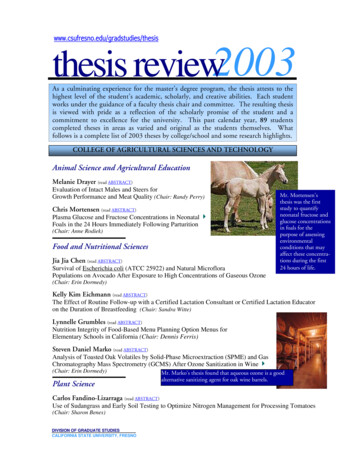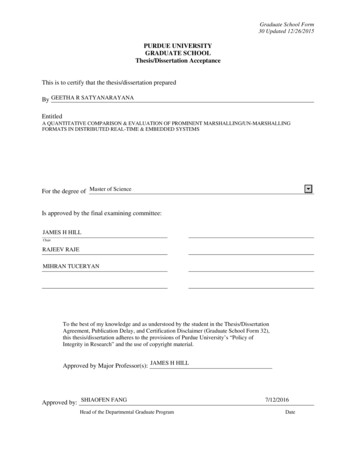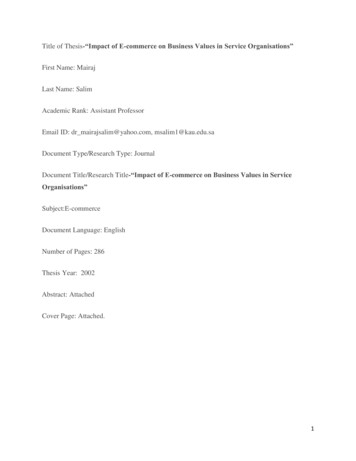
Transcription
Title of Thesis-“Impact of E-commerce on Business Values in Service Organisations”First Name: MairajLast Name: SalimAcademic Rank: Assistant ProfessorEmail ID: dr mairajsalim@yahoo.com, msalim1@kau.edu.saDocument Type/Research Type: JournalDocument Title/Research Title-“Impact of E-commerce on Business Values in ServiceOrganisations”Subject:E-commerceDocument Language: EnglishNumber of Pages: 286Thesis Year: 2002Abstract: AttachedCover Page: Attached.1
THE IMPACT OF E-COMMERCEONBUSINESS VALUE IN SERVICEORGANISATIONSABSTRACTTHESISSUBMITTED FOR THE AWARD OF THE DEGREE OFDoctor of PhilosophyINBUSINESS ADMINISTRATIONBYMAIRAJ SALIMUnder the Supervision ofDR. JAVAID AKHTERAssociate Professor of Business AdministrationFaculty of Management Studies and ResearchDEPARTMENT OF BUSINESS ADMINISTRATIONFACULTY OF MANAGEMENT STUDIES AND RESEARCHALIGARH MUSLIM UNIVERSITYALIGARH (INDIA)20022
AbstractIntroductionThe thesis deals with the study of “The Impact of Electronic Commerce on Business Value inService Organisations”. Though the scope of the study extends to many service organisations,emphasis has been laid down on the study Banking, Finance, Insurance, Entertainment,Education, Software, Consultancy, Electronic Commerce Solution and Telecommunicationorganisations.Electronic Commerce refers to all value transactions involving the transfer of information,products and services or payments via electronic networks. Electronic Commerce is recently anew mode of conducting business and its history can be traced back to1960s.When organisations redefine the products, processes and business models using technology tochange the ways products are conceived, marketed, delivered it is said to have derived thebusiness value. The main components of Business Value are Product Promotion, New SalesChannel, Direct Saving, Time to Market, Customer Service, Brand Image, CustomerRelationship, Technology and Laboratory Learning, New Product Capabilities and New BusinessModels.Through this study, area of interest has been explored after an extensive literature review whichshows that no research have been conducted before on this aspect of The Impact of ElectronicCommerce on Business Value in Service Organisations.Contents of the ThesisThe study has been divided into five chapters. The first chapter presents an overview ofelectronic commerce followed by meaning and definitions, historical background, benefits,barriers, views, types of e-commerce, strategies challenges etc. It aims at providing the reader anoverall idea about the nature and activities of electronic commerce.The second chapter entitled „The Concept of Business Value and Measurement‟ briefly describesthe meaning and other relevant specific details of business value.3
The methodology of research adopted for the purposes of the present study has been presented inchapter three. The chapter consists of extensive literature review to establish the need for study,the scope of study, conceptual framework of electronic commerce, impact of electroniccommerce, survey reports, case studies, present models of electronic commerce, data collectionmethods and procedures, hypothesis and analytical techniques used have been included in thischapter, under separate sections.Chapter four of the thesis analyses and interprets the overall overview on the Impact ofElectronic Commerce on Business Value on all the sectors of service organisations as well aswith reference to Annual Group Turnover, percentage of Annual IT spending and percentage ofElectronic Commerce spending.Chapter five presents suggestions and recommendations of this study.References used in the study appear at the end of each chapter. The list of books, journals,magazines, web sites visited and referred to have been appended at the end of the thesis in theform of Bibliography. Besides this general information about e-commerce has been given inAppendix I, II, and III. In Appendix IV questionnaire, glossary, useful web sites and e-mail Idsare given and in the last Appendix V calculations for F and Z tests are given.Objectives of the StudyImportant Objectives of the study are stated as follows: To what extent Electronic Commerce has the Impact on Business Values on all thesectors of service organisations. To what extent Electronic Commerce has had a varying Impact on Business Values withreference to Annual Group Turnover of the organisations To what extent Electronic Commerce shows Impact on Business Values with reference toAnnual percentage of IT spending. To what extent Electronic Commerce has the maximum Impact on Business Values withreference to percentage of Electronic Commerce spending in an organisation.4
Methodology of ResearchKeeping in view the objectives of the study, and in order to justify the need for research, theresearcher has conducted a review of existing literature in the subject. This led to identificationof research gaps.In formulating the research problem, the major components of Business Values have beenchosen for the present study. In view of the nature of study, exploratory research design has beenselected. The researcher has constructed a questionnaire based on the dimensions of theseBusiness Values and respondents in selected service organisations were ask to rank the extent ofthe Impact of Electronic Commerce on these Business Value components. The frameworkproposed by Michael Bloch, Yves Pigneur & Arie Segev in their paper On the Road ofElectronic Commerce--A Business Value Framework, Gaining Competitive Advantage andSome Research Issues has been used.In collecting information, primary sources have been considered as population sample. Data hasbeen collected through a structured questionnaire developed on a five-point scale. Data wasentered on tabulation sheet using MS Excel. Thereafter overall mean of various scores was taken.The mean was then compared with the mean of different components of Business Values. Thecomparison could have resulted in difference between population mean and mean of specificsegment of population. In order to know that this difference was statistically significant or notpopular F and Z tests were applied.In other words, had there been an equal number of respondents in each group of subgroup ormore than our present sample size i.e. 135 we would have obtained same mean. This is our nullhypothesis (H0). We have tested this at significance level of 5% in both the cases and findingswould have been more appropriately discussed and analysed at various level of significance.Main Findings of the StudyOn the basis of analysis following results are made on all the sectors of service organisations ofthe Impact of Electronic Commerce on Business Value.Brand Image- Analysis shows Electronic Commerce has the maximum impact on Brand Image.Banking and Electronic Commerce Solution industry have taken full advantage of theopportunities offered by Electronic Commerce.5
Customer Service- Findings show that Customer Service has maximum impact on Software,Consultancy, Telecommunication and Entertainment industries. These industries enjoyed themost benefits offered by Electronic Commerce.New Business Models- Analysis shows that no particular service organistion has taken fulladvantage of the opportunities offered by Electronic Commerce business models on any of thecomponents of Business Value. This also shows that all service organisations can take advantageof Electronic Commerce business models in developing their business models.Product Promotion- Overall analysis shows that no service organisation has taken full advantageof Electronic Commerce opportunities offered by it, which shows that all service organisationscan promote their products using Electronic Commerce.Customer Relationship- Customer Relationship has the maximum impact on Finance andInsurance companies, which shows that these industries have taken full, benefits of CustomerRelationship related opportunities offered by Electronic Commerce.Direct Saving- Analysis on the basis of service organistions shows that Education and Othercompanies have the maximum impact on Direct saving using Electronic Commerce.Time to Market- Overall maximum impact of Electronic Commerce on Time to Market showsthat no service organistaions has the impact on any of the Business Value components, whichshows that Electronic Commerce helped all service organisations equally for its customers togive Time to Market.Technology and Laboratory Learning- Technology learning after Time to Market shows that itdoes not have any impact on any of the components of Business value in any of the serviceorganisations, this shows that it offers opportunities to all service organisations for newTechnology and Laboratory Learning either equally or no impact at all.New Sales Channel- Comparing it with different service organisations analysis shows that noservice organisation has taken full advantage of the opportunities offered by ElectronicCommerce for New Sales Channel which shows that all service organisations can improve theirsales channel by using Electronic Commerce.6
New Product Capabilities- Analysis shows that this component of Business Value does not showany impact. Therefore organisations can take full advantage of the opportunities offered byElectronic Commerce for developing new product capabilities.On the basis of findings of present study following results are made on the Impact of ElectronicCommerce on Business Value with reference to Annual Group Turnover, percentage of AnnualIT spending, percentage of Electronic Commerce spending.Brand Image- Findings show that apart from Banking and Electronic Commerce Solutionindustry service organisations with Annual Group Turnover between 5500 and 10000 Cr andwhere % of Electronic Commerce spending 20% has maximum impact on Brand Image of theopportunities offered by Electronic Commerce.Customer Service- Analysis shows that service organisations with Annual Group Turnoverbetween 500-1500Cr and Annual IT spending 5Cr has maximum impact on Customer Servicein improving their services of the benefits offered by Electronic Commerce.New Business Models- Overall analysis shows that no service organisation with reference toAnnual Group Turnover, Annual IT spending, and % of Electronic Commerce spending showany significant impact on any of the components of Business Value.Product Promotion- Comparing it with different service organisations with reference to AnnualGroup Turnover, Annual IT spending, % of Electronic Commerce spending companies withAnnual IT spending between 250 and 4000 Cr has the maximum impact on Product Promotionand can be followed by other organisations as well to take full advantage offered by ElectronicCommerce.Customer Relationship- Overall Customer Relationship has the maximum impact on companieswith Annual Group Turnover 50-500 Cr, Annual IT spending 5 Cr and % of ElectronicCommerce spending 50-100% and have taken full advantages on Customer Relationship byusing Electronic Commerce.Direct Saving- On the basis of analysis Electronic Commerce has the maximum impact onDirect Saving on companies with Annual Group Turnover exceeding 10000 Crores. There wereof five organisations in the sample, where the turnover was in the range of billion/ milliondollars. This is an exception and hence cannot be generalised.7
Time to Market- Overall maximum impact of Electronic Commerce is on Time to Market withreference to % of Electronic Commerce spending between 20-50%.This shows that ElectronicCommerce have given full support to companies and their customers on Time to Market inbuilding its image and it may be followed by other organisations as well.Technology and Laboratory Learning- Technology and Laboratory Learning does not havemaximum impact on any of the Business Value components in any organisation and all serviceorganisations can take advantages from it.New Sales Channel- Organisations with Annual Group Turnover between 1500-5500Cr showmaximum impact on New Sales Channel and can be followed by other organisations as well totake advantage of the opportunities offered by Electronic Commerce.New Product Capabilities- Findings of the analysis show that this component of Business Valuedoes not show any impact comparing it with different service organisations Annual GroupTurnover, Annual IT spending and % of Electronic Commerce spending and is applicable to allservice organisations to have maximum impact for developing their new products.8
Information About ArticlesTitle: 1.“ Rural Marketing in India Problems Prospects Vis-à-Vis Globalisation”First Name: MairajLast Name: SalimAcademic Rank: Assistant ProfessorEmail ID: dr mairajsalim@yahoo.com, msalim1@kau.edu.saDocument Type/Research Type: JournalDocument Title/Research Title.“ Rural Marketing in India Problems Prospects Vis-à-VisGlobalisation”Subject: MarketingDocument Language: EnglishNumber of Pages: 08Name of the Journal/Conference: The Manager JournalPublishing Year: 2009Abstract: AttachedCover Page: Attached.9
Title: 2. “Technical and Vocational Training (TVET) as a Tool for Job Creation andUnemployment Reduction- Indian Perspective”First Name: MairajLast Name: SalimAcademic Rank: Assistant ProfessorEmail ID: dr mairajsalim@yahoo.com, msalim1@kau.edu.saDocument Type/Research Type: JournalDocument Title/Research Title“Technical and Vocational Training (TVET) as a Tool for JobCreation and Unemployment Reduction- Indian Perspective”Subject: MarketingDocument Language: EnglishNumber of Pages: 08Name of the Journal/Conference: The Integral JournalPublishing Year: 2009Abstract: AttachedCover Page: Attached.10
Title: 3. “Corporate Social Responsibility and Human Rights Dimensions: IndianPerspective” XXXII Indian Social Science CongressFirst Name: MairajLast Name: SalimAcademic Rank: Assistant ProfessorEmail ID: dr mairajsalim@yahoo.com, msalim1@kau.edu.saDocument Title/Research Title“Corporate Social Responsibility and Human Rights Dimensions:IndianPerspective” XXXII Indian Social Science CongressSubject: CSRDocument Language: EnglishNumber of Pages: 08Name of the Journal/Conference: ConferencePublishing Year: 2008Abstract: AttachedCover Page: Attached.11
4 Title : "The Potential of e-commerce in the Insurance Industry- The Road Ahead".First Name: MairajLast Name: SalimAcademic Rank: Assistant ProfessorEmail ID: dr mairajsalim@yahoo.com, msalim1@kau.edu.saDocument Title/Research Title: The Potential of e-commerce in the Insurance Industry- TheRoad Ahead.Subject: E-businessDocument Language: EnglishNumber of Pages: 07Name of the Journal/Conference: Global Journal of Enterprise Information System.Publishing Year: 2009Abstract: AttachedCover Page: Attached12
13
14
15
16
17
18
19
more than our present sample size i.e. 135 we would have obtained same mean. This is our null hypothesis (H 0). We have tested this at significance level of 5% in both the cases and findings would have been more appropriately discussed and analysed at various level of significance. Main Findings of the Study
